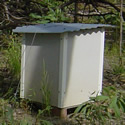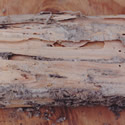Termite Simulated House Field Test Method
This methodology has been used in the U.S. and at locations in Australia to investigate a simulated service condition for wood inside structures that may be subjected to sub-terranean termite attack. An example of its use was in Mississippi in the 1980s in a study against Reticulitermes species, where relatively tall, but narrow structures were used. Later tests against Coptotermes species were carried out in Hilo, Hawaii and in the Rollingstone area of Queensland, Australia. More recently, the University of Melbourne has been working with a more sophisticated version of the test in the far north region of the Northern Territories in Australia.
Conceptually, the methodology involves testing framing and/or sill plate lumber, treated or otherwise, in an enclosed "house" structure where the walls are impervious to direct moisture ingress and with a "roof" structure that is reliable, but also easily removed for periodic inspections of termite activity. Extremely rapid termite activity can occur in this test method, with differentiation of attack often occurring depending of the distance of the material from the ground, and this can be dependent on termite species, as well as the presence or otherwise of untreated, or termite-susceptible wood within the structure. Inspection must be thorough, as the ingress of termites can be non-apparent on first perusal within the structure, but closer inspection can reveal the insidious nature of termite attack.
Methods that fall within this area have been well-documented, but standard methods have not been promulgated.
Images
References


